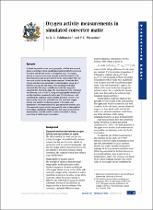JavaScript is disabled for your browser. Some features of this site may not work without it.
- ResearchSpace
- →
- Research Publications/Outputs
- →
- Journal Articles
- →
- View Item
| dc.contributor.author |
Tshilombo, KG

|
|
| dc.contributor.author |
Pistorius, PC

|
|
| dc.date.accessioned | 2010-03-26T10:31:36Z | |
| dc.date.available | 2010-03-26T10:31:36Z | |
| dc.date.issued | 2007 | |
| dc.identifier.citation | Tshilombo, KG and Pistorius, PC 2007. Oxygen activity measurements in simulated converter matte. Journal of the Southern African Institute of Mining and Metallurgy, Vol. 107, pp 123-128 | en |
| dc.identifier.uri | http://basemetals.org/Pt2006/Papers/247-252_Tshilombo.pdf | |
| dc.identifier.uri | http://hdl.handle.net/10204/4005 | |
| dc.description | Copyright: 2007 South African Institute of Mining and Metallurgy. | en |
| dc.description.abstract | The authors argue the possibility of using an oxygen probe to follow iron removal during converting, if local equilibrium is established between iron in the matte and the iron oxides in the fayalitic slag. The oxygen activity is expected to increase strongly as the iron content of the matte decreases (and the iron activity in the matte drops) while the iron oxide activity in the slag remains constant. To test this idea, oxygen activities were measured in synthetic mattes (made up of mixtures of Cu2S, FeS and Ni3S2) when in contact with silica saturated SiO2-FeO slags, and silica and (initially) magnetite saturated SiO2-FeO-Fe3O4 slags. The measurements were performed on laboratory scale at 1250°C, using an oxygen probe consisting of an MgO-stabilized zirconia electrolyte and Fe/FeO reference, and containing the sample in a silica crucible. Electrical contact to the matte was by means of a platinum wire. The measured oxygen activity was sensitive to the iron content of the matte, and insensitive to the composition of the gas atmosphere over the melt. The measured oxygen activity was generally close to that predicted by FactSage calculations. This indicates that such oxygen activity measurements could be useful to monitor iron removal during converting of nickel-copper-iron mattes | en |
| dc.language.iso | en | en |
| dc.publisher | South African Institute of Mining and Metallurgy | en |
| dc.subject | Fayalitic slag | en |
| dc.subject | Matte | en |
| dc.subject | FactSage calculations | en |
| dc.subject | Oxygen activities | en |
| dc.subject | Solid electrolyte | en |
| dc.subject | Slag | en |
| dc.subject | Iron | en |
| dc.subject | Mining | en |
| dc.subject | Metallurgy | en |
| dc.title | Oxygen activity measurements in simulated converter matte | en |
| dc.type | Article | en |
| dc.identifier.apacitation | Tshilombo, K., & Pistorius, P. (2007). Oxygen activity measurements in simulated converter matte. http://hdl.handle.net/10204/4005 | en_ZA |
| dc.identifier.chicagocitation | Tshilombo, KG, and PC Pistorius "Oxygen activity measurements in simulated converter matte." (2007) http://hdl.handle.net/10204/4005 | en_ZA |
| dc.identifier.vancouvercitation | Tshilombo K, Pistorius P. Oxygen activity measurements in simulated converter matte. 2007; http://hdl.handle.net/10204/4005. | en_ZA |
| dc.identifier.ris | TY - Article AU - Tshilombo, KG AU - Pistorius, PC AB - The authors argue the possibility of using an oxygen probe to follow iron removal during converting, if local equilibrium is established between iron in the matte and the iron oxides in the fayalitic slag. The oxygen activity is expected to increase strongly as the iron content of the matte decreases (and the iron activity in the matte drops) while the iron oxide activity in the slag remains constant. To test this idea, oxygen activities were measured in synthetic mattes (made up of mixtures of Cu2S, FeS and Ni3S2) when in contact with silica saturated SiO2-FeO slags, and silica and (initially) magnetite saturated SiO2-FeO-Fe3O4 slags. The measurements were performed on laboratory scale at 1250°C, using an oxygen probe consisting of an MgO-stabilized zirconia electrolyte and Fe/FeO reference, and containing the sample in a silica crucible. Electrical contact to the matte was by means of a platinum wire. The measured oxygen activity was sensitive to the iron content of the matte, and insensitive to the composition of the gas atmosphere over the melt. The measured oxygen activity was generally close to that predicted by FactSage calculations. This indicates that such oxygen activity measurements could be useful to monitor iron removal during converting of nickel-copper-iron mattes DA - 2007 DB - ResearchSpace DP - CSIR KW - Fayalitic slag KW - Matte KW - FactSage calculations KW - Oxygen activities KW - Solid electrolyte KW - Slag KW - Iron KW - Mining KW - Metallurgy LK - https://researchspace.csir.co.za PY - 2007 T1 - Oxygen activity measurements in simulated converter matte TI - Oxygen activity measurements in simulated converter matte UR - http://hdl.handle.net/10204/4005 ER - | en_ZA |






